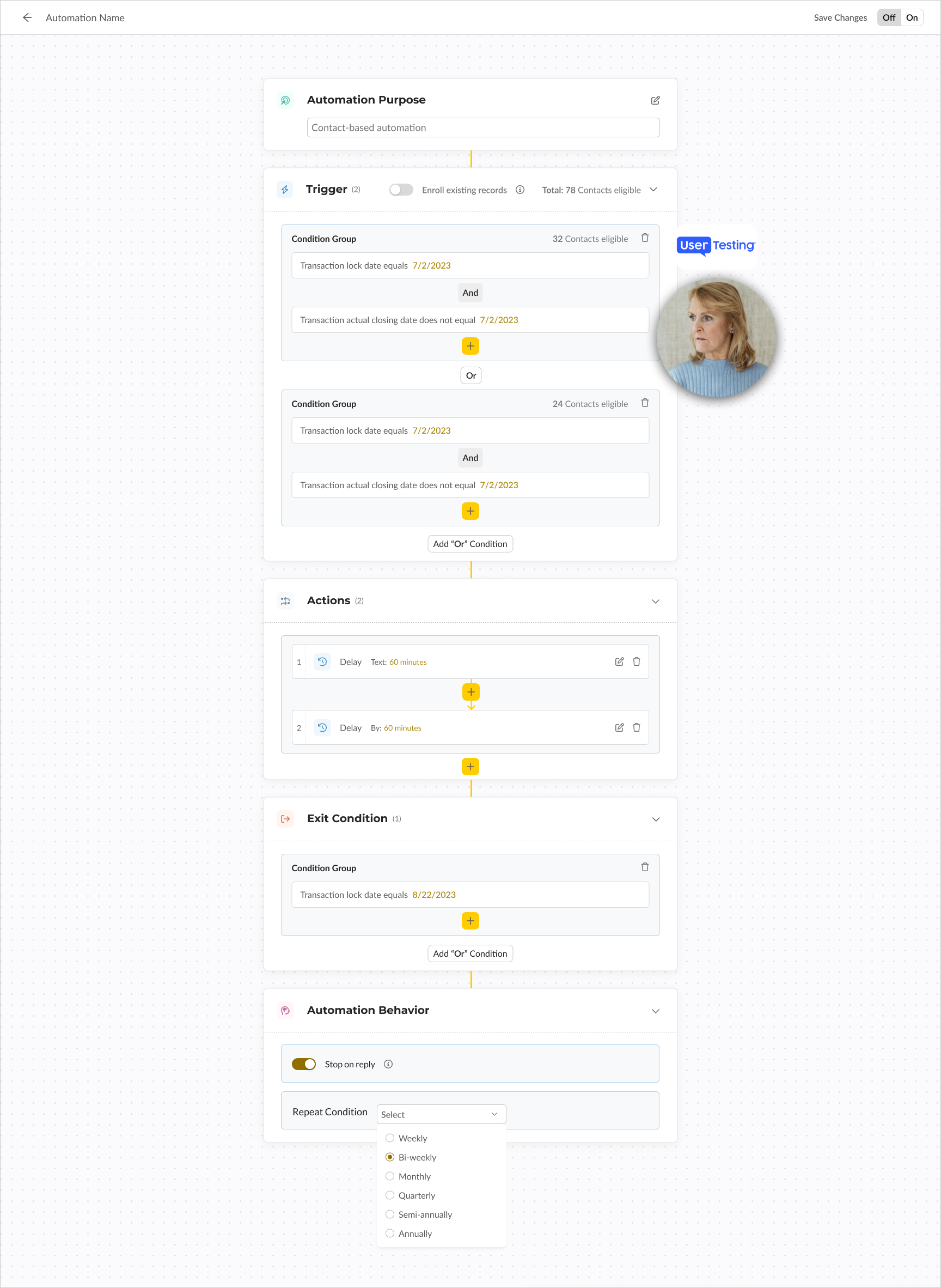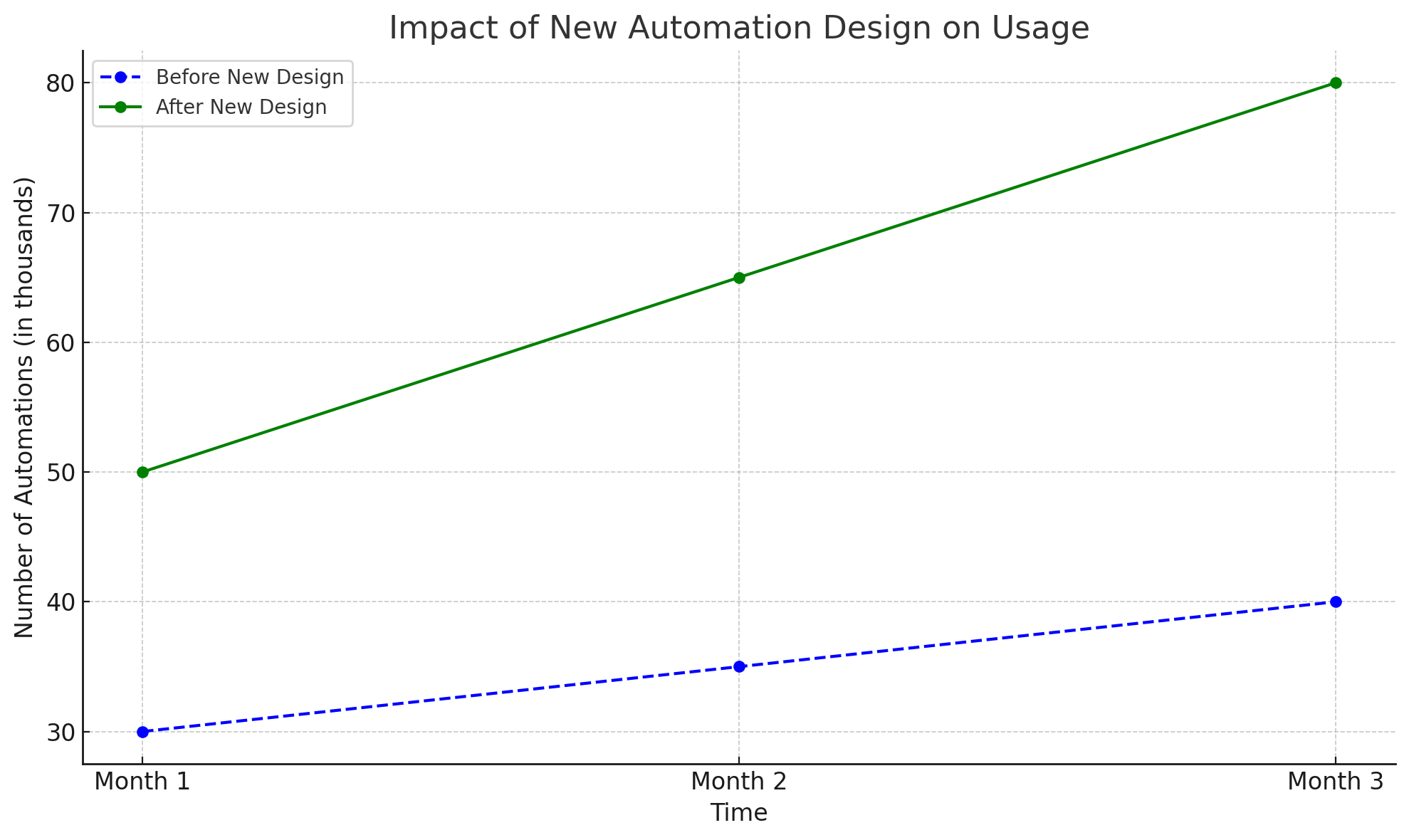
Senior Product Designer at Aidium
Automation engine - SaaS CRM.
Context
Aidium (Daily-AI) is an Enterprise SaaS CRM for mortgage loan officers. When a lead enters the system, the loan officer manages a chain of events to complete a loan application. The users who are the loan officers needed an automated system that would guide their customers through the funnel and replace the overhead of manually managing each customer in their journey to a complete loan.
Why it’s important?
Completing a loan depends on constant contact with new leads and clients. A busy loan officer could be overwhelmed if they manually manage each contact’s journey through the loan application process. An automation system will dramatically reduce workload and increase the frequency of communication with their customers. As a result, more loans will be closed.
Discovering the problem
At Aidium, I regularly spoke with CRM users. I also checked in with loan officers and admins of different organizations and learned that they need to automate communications with their clients. The users reported that once a lead enters their funnel, different workflows must be created to convert the lead to a client and close a loan.
The main pain point was tracking the Workflow and ensuring all necessary communications were sent out on time.
Additionally, there was a need to automate “one-off” communications, called Campaigns, such as sending an email celebrating a life event or a client's loan anniversary.
Problem Statement
Workflows and Campaigns need to be automated for loan officers to advance the loan application in a personalized manner.
The Product Team
-
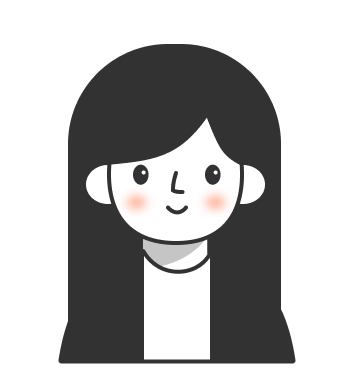
Mali (Me!)
DESIGNER
-
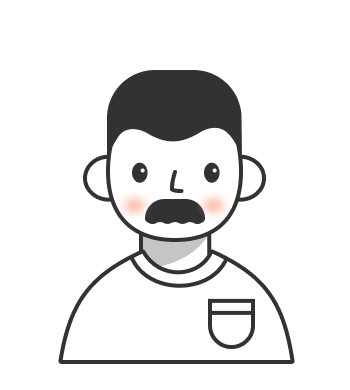
Rob
PRODUCT MANAGER
-
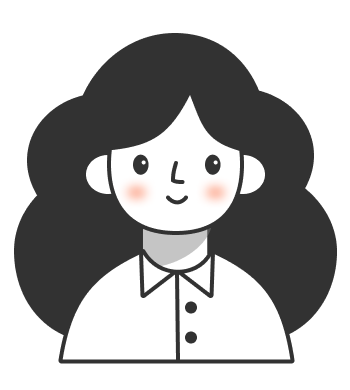
Katheryn
FRONTEND ENGINEER
-
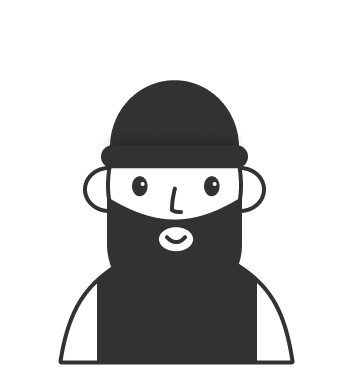
Karl
BACKEND ENGINEER
As a senior product designer working on CRM automation, my role centers on understanding user needs, designing intuitive workflows, and ensuring a seamless experience that aligns with business goals. I collaborate closely with product managers, researchers, and stakeholders to define the scope and objectives, conduct user research, and analyze feedback to identify pain points and opportunities.
My responsibilities include creating wireframes, prototypes, and interaction flows for automation setup, triggers, and actions while ensuring accessibility and inclusivity. I work with engineering to deliver detailed design specifications, participate in design reviews, and iterate based on usability testing and feedback.
Throughout the process, I advocate for the user, ensuring the solution is both effective and delightful, driving value for the business and its customers.
What does success look like?
Success for CRM automation would mean creating a feature that empowers users to save time, reduce manual effort, and improve workflow efficiency while being intuitive and enjoyable to use. Specifically, success could be measured by:
Adoption and Engagement: A high percentage of users actively leveraging the automation feature, with repeat usage and positive engagement metrics.
Ease of Use: Users can set up and manage automation with minimal friction, as indicated by low error rates, reduced support tickets, and high usability test scores.
Time Savings: Clear evidence that automation reduces time spent on repetitive tasks, freeing users to focus on more strategic activities.
Customer Satisfaction: Positive feedback from users, reflected in improved Net Promoter Scores (NPS), Customer Satisfaction Scores (CSAT), or qualitative testimonials.
Business Impact: Increased efficiency and productivity for businesses using the CRM, leading to measurable ROI through higher retention, customer success, or operational efficiencies.
Scalability and Reliability: A robust feature that handles diverse use cases across industries without breaking or causing frustration, ensuring long-term adoption and trust.
Ultimately, success is a product that integrates seamlessly into users’ workflows and delivers both immediate value and long-term satisfaction.
How did I come to my proposed solutions?
To come up with a proposed solution for CRM automation, I followed a structured, iterative approach that prioritized user needs, aligned with business goals, and leveraged collaborative team insights. First, I conducted user research to uncover pain points, goals, and workflows related to CRM tasks that could be automated. This included interviews, surveys, and analyzing behavioral data, along with reviewing support tickets to understand recurring frustrations. I also worked with stakeholders to identify business objectives and ensured the solution aligned with key priorities like customer retention and operational efficiency.
Next, I mapped out the current workflows for tasks users wanted to automate, identifying friction points and opportunities for improvement. Using this foundation, I facilitated brainstorming sessions with cross-functional teams to generate potential solutions. I then sketched and prototyped concepts, focusing on how users would create and manage automation workflows, while incorporating best practices and competitor insights.
To validate the ideas, I tested early prototypes with real users, gathering feedback on usability, clarity, and effectiveness. Based on their input, I refined the designs to improve the experience. Throughout the process, I collaborated with engineers to ensure feasibility and scalability and worked closely with product managers to align the solution with both user and business needs.
Finally, I developed a detailed proposal that included user journeys, wireframes, prototypes, and an interaction guide. I presented the solution to stakeholders, providing clear rationales for my design decisions, supported by research and data. This process ensured the final design was intuitive, effective, and strategically aligned.
Exploring ideas
To come up with a proposed solution for CRM automation, I followed a structured, iterative approach, testing ideas at both low and high fidelity to refine the user experience. Initially, I facilitated brainstorming and ideation sessions using Miro to map out workflows, sketch rough wireframes, and collaborate with cross-functional teams. This allowed us to quickly explore multiple concepts, prioritize ideas, and iterate on the flow of automation creation and management.
Once we identified promising directions, I created low-fidelity wireframes in Figma to visualize the interface and core interactions. These were shared with the team and stakeholders to gather feedback on the overall structure and flow. With input in hand, I iterated further and moved to high-fidelity click prototypes in Figma, simulating the end-to-end experience of creating and managing automation.
These high-fidelity prototypes were tested with users in usability sessions to evaluate clarity, ease of use, and effectiveness. Participants were asked to complete tasks such as setting up triggers, defining actions, and reviewing automation results. This feedback provided critical insights into pain points and areas for improvement.
Throughout the process, I iteratively refined the prototypes based on user feedback and technical feasibility discussions with engineers. This combination of low-fidelity exploration in Miro and detailed, interactive prototypes in Figma allowed us to test, validate, and evolve ideas effectively, ensuring the final design met both user needs and business goals.
Proposed Solution
To arrive at an automation design that differentiated between campaign and workflow automations, I followed a user-centered and iterative process, leveraging research, collaboration, and prototyping to create a solution that addressed distinct user needs. Here's how I approached it:
1. Understanding User Needs
I began by conducting user research through interviews and surveys with CRM users to understand their automation goals. From this research, two primary use cases emerged:
Campaign Automations: Short-term, goal-specific automations, such as sending a series of emails for a product launch or promotion, which expire once completed.
Workflow Automations: Continuous, ongoing processes designed to guide clients through a sales or service pipeline, automating communications and updates.
I analyzed these findings alongside behavioral data and support feedback to identify pain points, such as confusion between one-off and ongoing automations in existing tools.
2. Defining the Concept
Using insights from research, I worked with product managers and stakeholders to define the key distinctions between campaigns and workflows. Campaigns would have a defined start and end point, focused on achieving a specific outcome. Workflows would be evergreen, adapting to a client's position in the pipeline and ensuring seamless communication over time.
3. Low-Fidelity Prototyping in Miro
To explore ideas, I used Miro to map user journeys for both automation types, identifying key decision points and interactions. I created flow diagrams and rough wireframes that visualized how users would set up and manage these automations, emphasizing simplicity and clarity in differentiating the two types.
4. High-Fidelity Prototyping in Figma
After refining the initial concept, I created high-fidelity click prototypes in Figma to simulate the user experience. These prototypes showcased:
A dashboard view that clearly separated campaign and workflow automations, helping users quickly choose the appropriate type.
Campaign Setup: A streamlined wizard guiding users through creating time-bound automations with specific triggers and end dates.
Workflow Builder: A flexible interface with drag-and-drop functionality for designing ongoing automations, including triggers, actions, and conditional steps.
5. Testing and Iteration
I tested the prototypes with users, asking them to create both campaign and workflow automations. Feedback highlighted areas of confusion, such as terminology and interface complexity. I iterated to improve the distinction between the two automation types by:
Adding contextual tooltips and visual indicators (e.g., icons or color coding).
Including a brief setup overview explaining the key differences at the start of the process.
6. Collaboration and Finalization
I worked closely with engineers to ensure technical feasibility, particularly for the dynamic elements of the workflow builder. I also collaborated with product managers to define success metrics, such as adoption rates and time saved by users.
Outcome
The final design offered a seamless experience for both campaign and workflow automations, empowering users to handle short-term and long-term automation needs effectively. Campaigns provided a clear, goal-oriented setup for time-bound tasks, while workflows offered a flexible, ongoing system to manage client communications and progress through the pipeline.
How did the proposed solution solve the problem?
Here is a chart showing the impact of the new automation design on the usage of automation in the CRM platform over three months. The significant increase in usage after implementing the design highlights its success in meeting user needs and improving engagement.



